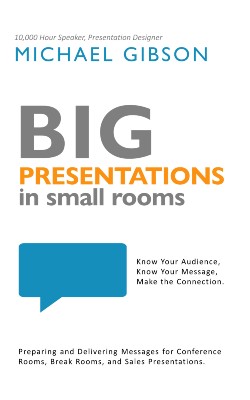PRESENTATION SUCCESS: SIMPLE, NOT EASY
The basics of presentation success are contained in the mantra.
This realization came to me as I was sitting with my laptop creating content for an upcoming training.
It all comes down to this:
Know your audience.
Know your message.
Make the connection.
Got it? Three straightforward statements. But can you prove them? Can you prove that you know your audience, know your message, and can make the connection? The implementation is the challenge. The Mantra is simple but not easy.

Every chapter of my book, every blog on my website, and every episode of the podcast supports the mantra. This is purposeful. Each element of the mantra should guide every step of your preparation, practice, and delivery. How well you apply the mantra is determined by the time available, the information available, and the personal investment you have in the presentation. Use what you have to make the best presentation possible.
PRESENTATION SUCCESS: KNOW YOUR AUDIENCE
Who are you connecting with? Who will be in your audience?
Group Identity
The group itself might have an identity. Perhaps you are talking to an executive team, or a peer group at work, or a group representing a potential client. The identity of the group should shape your approach. Here are a few big categories to keep in mind. Is the group internal or external? If internal, is the group is made up of those under your authority, those who are peers, those who are in authority over you? If external, what authority does the group have? Can they make the decision or are they making recommendations to the decision-makers? Is there another presentation you will be making if you make it past the current group? Knowing your audience means knowing the group.

Individual roles
Every group is made up of individuals. And each individual has a workplace role. If you can identify the roles present, you will be better able to understand the responsibilities and concerns of each person. This too should guide your approach. If you are dealing with people from the finance department, they might have different concerns than the person from the safety department, and both sets of concerns are different from those of the marketing department.
Individual personalities Each person present will have a personality that will affect your presentation. Some will be more outgoing and willing to speak up and ask questions. Others will be more reserved. While others will be more critical and look for problems within your information or your idea. Realizing the reality of various personalities will help you relax and take it less personally when some are more engaged than others. It will also help you connect with each person in ways that they appreciate.
PRESENTATION SUCCESS: KNOW YOUR MESSAGE
Know your audience and know your message.
Knowing the goal is key to creating the message. For presentation success, know what your goal is and how your words and images can best lead the audience toward that goal. And knowledge of your time limit will allow you to craft a message that honors that constraint.
Three common types of presentations are the update, the proposal, and the combo.
The Update
The update is information-based. Where are we in the process? How is it going? Are we meeting our commitments within our limitations? What do we need to know in order to make the best decisions at this point in time? Based on your knowledge of the audience you can predict the concerns and questions associated with the project, and craft your message to address as many as possible within the time constraint.
The Proposal
The Proposal is future-based. The presenter is encouraging the audience to make a specific decision, to go in a certain direction. Based on your knowledge of the audience you can predict the concerns and questions associated with your idea and can meet the needs of the audience with the content of your presentation—within the time constraints.
The Combo
In high-trust environments, The Combo is a common scenario. Combos occur when the person presenting an update is expected to provide information, context, insight, and what they think the next steps should be. What begins as an update becomes a proposal. The group is not required to follow that proposal, but they welcome the ideas of the person providing the update. Based on your knowledge of the audience you can predict the concerns and questions associated with the information and any possible suggestions, and you can keep those in mind as you craft a message to fit within the time constraints.
The Time Constraints
This limitation should be always in mind as you create your message. The time constraint forces you to prioritize update information. It requires you to prioritize supporting content for your proposal. It is OK to finish a little early. Do not finish late.

PRESENTATION SUCCESS: MAKE THE CONNECTION
You know your audience. You know your message. And now you are determined to make the connection.
Audience connection can happen before, during, and after the presentation. You might not have opportunities in all three times. Take advantage of the opportunities you do have.
Before
Be a helpful encouraging presence whenever you are with the audience. This is an ongoing positive presence. If you try to create it at the last minute, it will be suspect. You can create this presence whether your time is limited or long. Be someone that other people are glad to see.
During
When you present, have an appropriately engaging presence. Be quick to smile. Use eye contact to create connections with every audience member. Pursue confident humility. Know your stuff. And be willing to say you don’t know when that is the case… but be determined to find out and follow up. Be thankful for the opportunity and respect the time.
After When possible, have brief conversations immediately following the meeting. Then, if possible follow up on other ways that are appropriate for the situation. Perhaps a summary of your content along with appreciation for the opportunity. This can serve the dual purpose of personal connection and reconnection with the message. Win-win!

PRESENTATION SUCCESS: YOU CAN ACHIEVE IT!
Whenever you have the opportunity to deliver a presentation, remember the mantra.
Know your audience.
Know your message.
Make the connection.
It is simple, but it is not easy. The outcomes are worth the effort, so be determined to invest your time and energy in ways that will allow you to deliver Big Presentations in Small Rooms.
Want to know more? Keep reading the blog!
Do you prefer to listen? Check out The Big Presentations Podcast! Want to know even more? Order the book Big Presentations in Small Rooms!




